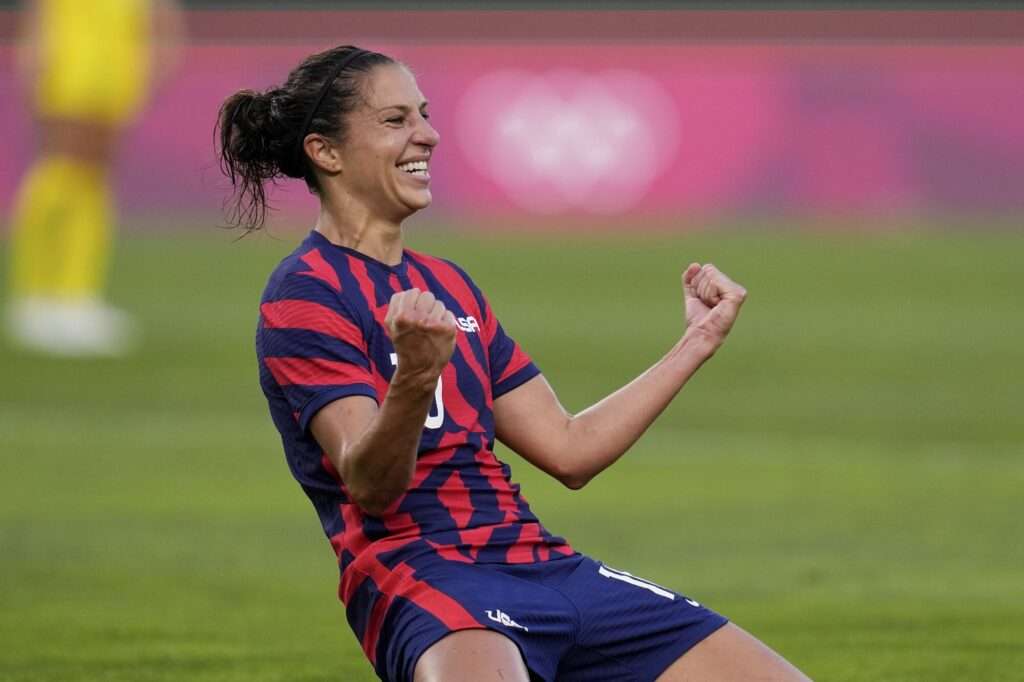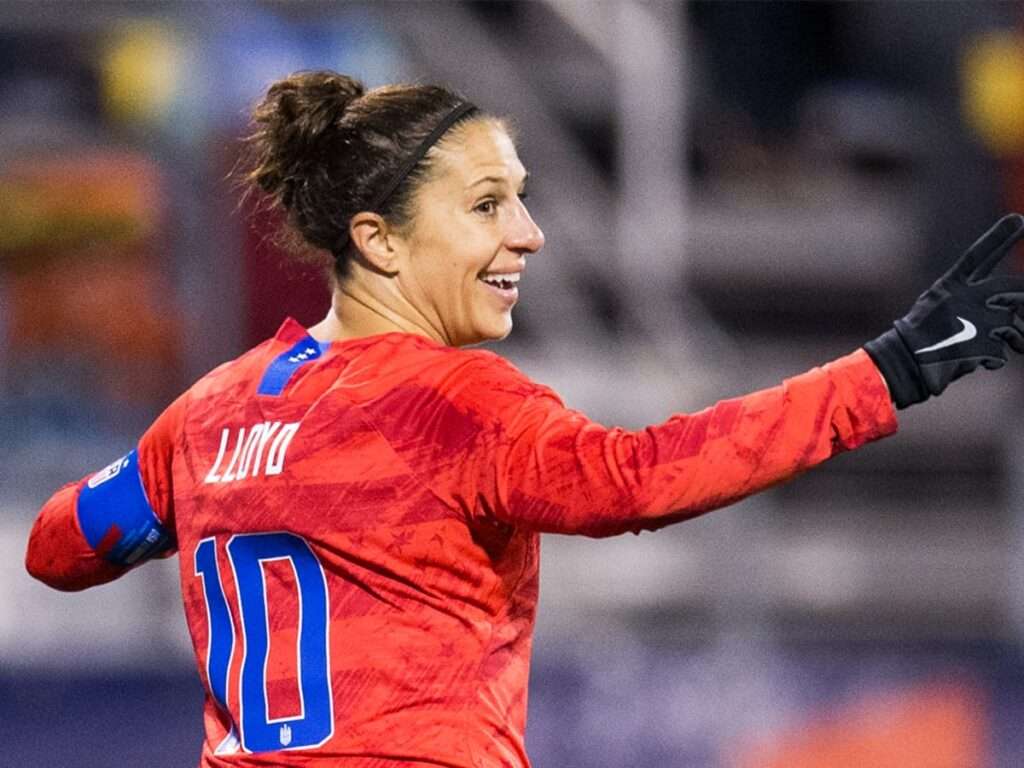
Soccer Star Carli Lloyd Talks Retirement Life at 39 and Her Next ‘Great Transition’
Carli Lloyd no longer competes professionally, but don’t expect her “to be one of those retired soccer players that disappear.”
Lloyd, 39, first announced her retirement from professional soccer in August 2021. Two months later, on Oct. 26, 2021, the athlete played on the U.S. women’s national team for the final time. She ended with 134 career goals, which is the third-most in U.S. history behind only Abby Wambach and Mia Hamm.
“It’s an interesting space to transition into, kind of the unknown, but I think that’s what makes it exciting,” Lloyd tells PEOPLE of retirement life. “I must say, I’m really enjoying it. Of course, I always love the game of soccer, but it was just time all around on many different levels. … It’s funny, I retired at the same time as my parents.”
Lloyd spent 12 years playing professional soccer. She represented the U.S. at 2008, 2012, 2016 and 2020 Olympics and became the first American to score in four different Games. In Tokyo, last summer, the two-time FIFA Women’s World Cup champion was the oldest American female to play in an Olympic soccer tournament. The USWNT won a bronze medal, which added to Lloyd’s two gold medals from the 2012 London Games and 2008 Beijing Games.
The soccer star details to magazine her life off the pitch, her next career move as Teqball USA’s first celebrity athlete, and her hopes for the next generation of soccer players.
How is retirement at age 39?
I feel just really at peace and content, just grinding and working hard away from the pitch now, which is a little different. But still, the same Carly that wants to continue to grow and evolve and be better every day. It’s been really nice to just have more time to be able to do things that I’ve put on hold and to spend time with my husband and friends and family.
Was there a period of transition where you were like, “I don’t have to do this anymore?”
I would say, just the everyday grind. The training, it just consumed, pretty much my whole life, around the clock. … All of my extra strength training, all my running and extra reps that I would usually do, it really frees up my days. I would say that is pretty much the bulk of not really having to do that anymore so it’s been really nice. I’m packing in my days with a lot of other things, domesticated things, like working out, landscaping, and just projects around the house.
How did you first get into Teqball? [Teqball combines elements of football and table tennis and is played on a curved table. The players hit a football back and forth with any part of the body except arms and hands.]
I actually saw it on social media. [Cristiano] Ronaldo, [Lionel] Messi, [David] Beckham, Neymar were playing during the pandemic, especially not being able to play some games and the season was halted at some point for some of these leagues. I was able to get a table during the pandemic in 2020. I was also home for 10 months straight because I was recovering from knee surgery. … It’s actually really hard, but it’s really beneficial because I’ve been someone who grew up playing soccer and tennis, which works everything: your first touch, your awareness, your accuracy, all of those things. So when you have a Teqball table, it’s incredibly valuable for just everything. It was a lot of fun to be able to use it. Then here we are, grateful and honoured to be the first female ambassador for Teqball USA, it’s pretty cool.
They’ve got a goal of the sport becoming an Olympic sport by L.A. 2028. It just continued to immerse me around the game of soccer, to be able to meet Teqball players, participate in local tournaments — it’s just really fun. It’s definitely a great transition to be able to continue to stay involved in the sport, whether it looks a little bit different on a pitch or on this table.
How would you describe the new sport?
It just is a really fun, challenging game. But I would say that even though it’s curved on both sides and it does make it very difficult — and you have to be very accurate — it’s fun for anybody to pick it up and play. I mean, I’ve been playing soccer my whole life and there are things that players do that I probably could never do.
I would say that everybody can do it. It involves a lot of cardio, running and shifting. You can use your head, you can use your chest, you can use your feet. Whether you’re good or not, the good thing is if you’re partnered with somebody that does have a good touch and does have some sort of soccer background, they can help you out.
You represented the USWNT crest for so many years. What are you proud to represent now in retirement and in these next chapters of your life?
I just want to help grow the game. I want to help people, help the sport continue to grow, and bring awareness. I think that’s the main thing. My goal, and really every soccer player that has started out on the national team, you want to leave the sport better than when you came into it. I and some of my teammates, we have done that.
We all have continued to push and break barriers along the way. I’m not going to be one of those retired soccer players that disappear. I’m going to be definitely involved in many different ways. That’s the biggest goal is continuing to talk about the sport and raising awareness for girls and boys to continue to get involved. Teqball is another avenue for kids. Maybe they don’t have what it takes to play on the actual soccer field and here’s a pretty amazing, challenging table that could be a goal of theirs as well.
What was your reaction to the $24 million payment to USWNT players and the promise from the U.S. Soccer Federation that the women’s and men’s teams will be paid at an equal rate?
It is definitely a relief. It’s been a long six years and it’s been challenging. There’s been tension. No one ever wants to be fighting with their employer. It just makes for a difficult situation all around, so I know that it’s obviously contingent on the collective bargaining agreement, the men and women have to agree upon that. I am out of the loop so I am not sure how all of that is going. I’m hopeful, but we did set out to do something remarkable. We obviously shook some trees, we ruffled some feathers and we pushed. We’re just trying to make things better for the next generation. Because for so long, it was: just play, just be grateful.
All of us were scared to fight, to go down that road, because the ramifications of potentially striking, of potentially not getting paid, that’s a scary thing. So yeah, really proud of the group. I’m hopeful. I still think we have a long way to go. I’ve been pretty vocal, especially being freshly retired.

On March 2, you posted a video about the culture shift in the USWNT over the years and your clarification about the “never say die” attitude. What kinds of future shifts are you enthusiastic or hesitant about?
I think no matter how many times I explain it, people just want to push whatever narrative they feel is necessary. That is the wonderful beauty of our world currently and the state of our world, unfortunately. But for me, it is so simple: the cultural shift that we’ve seen on the field has been different. We have been successful forever, for decades and decades, and the world is catching up to us. The gap is closing. So for us to continue to be at the top and for the national team to continue to be successful, you can’t take anything for granted. You can’t walk out onto the pitch and think that any game is going to be a cakewalk. The message that I left with is teaching the younger players that your foot has to be on the pedal at all times, full throttle. You can never take it off. Just when you’re starting to feel a little bit comfortable, that’s when it’s going to come tumbling down.
Teams are becoming smarter tactically, teams are becoming more technical, mentally tougher, fit. We used to be able to steamroll over teams by being fit, by being mentally tough, but it’s become a lot harder now. The game, breaking down teams, and figuring out ways to disassemble teams on the field has become a lot harder. I think that’s a good thing because we want to see the women’s game continuing and growing, which it is. It’s becoming harder and harder so it’s the U.S. national team’s job to keep going. They have to keep breaking those limits and keep pushing on because it’s just going to make the rest of the world better.
It was disappointing this last bronze medal game in Tokyo, to not come away with the gold medal. The cultural shift that the people were seeing, which again what I said was not breaking news, because it was talked about in Tokyo as well. The broadcasters talked about it, news media outlets talked about it. You could just see that our group was not collective. Our group was not together and our group was disjointed. I think that is sort of the next generation’s job: how can you collectively get back to being one? How can you collectively have the same goals?
You may have differing opinions, different feelings, different values and all of that. But when you step in between those lines, there has to be one collective goal, that is my hope. I felt glimpses of that at the SheBelieves Cup with the team, with the younger group. Hopefully, they just continue to have that “never say die” attitude and continue to keep separating that gap because the whole world is catching up to us. Everyone’s been chasing us, and we want that to stay the same. We want everyone to continue to be chasing us. But the only way you’re going to do that is to have one collective goal, be together and work as hard as you possibly can every day to get better.
What does winning look like for you these days?
Well, life feels a lot different. … I went out to a Sixers game the other night. If I did that while I was still competing or while I was still training, every thought in my mind would be about getting up the next day and having to work out. What am I eating there? What am I drinking? There was just this constant thought process going on for 17 straight years, the pressure, having to perform and having to get through obstacles. It’s a lot and it was hard, now I don’t have the pressure.
I don’t have to go out and prove anybody wrong. So for me, winning is just continuing to be me, continuing to evolve, grow and help the next generation of players. That is the biggest thing, through my CL10 clinics, speaking to young girls and boys, and just finding ways to make a change. That’s my winning, trying to be a good person and spread love, kindness and respect to everyone I come in contact with.

Mrs Vicky m Bournel has made this magazine proud. She is not only an Author from America for Lakkars Magazine she is the Chief Editor of Lakkars Magazine for the articles.


